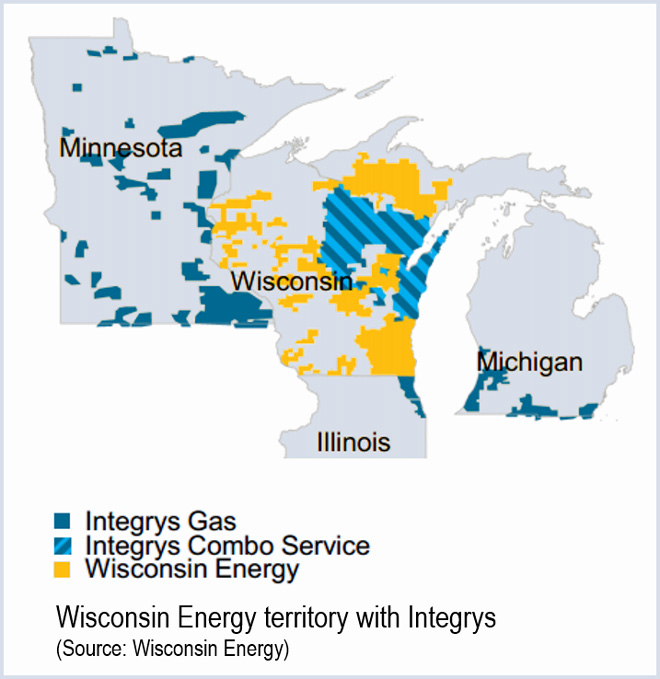By Chris O’Malley
Wisconsin Energy Corp. profits fell 16% in the fourth quarter on warmer weather and $6 million in costs related to its proposed acquisition of Integrys Energy.
The Milwaukee-based gas and electric utility earned $121.4 million ($0.53/share) versus $144.3 million ($0.63/share) in the fourth quarter of 2013. Revenue rose to $1.23 billion from $1.18 billion during the same quarter last year.
For the year, earnings rose 2%, to $588.3 million, or $2.59 a share — dinged 6 cents due to Integrys acquisition costs.
Full-year results were buoyed by colder weather in early 2014 that increased demand for natural gas. The utility also cited cost controls and lower employee health care costs.
During a Feb. 11 conference call with analysts, Wisconsin Energy Chairman and CEO Gale Klappa pointed to a 1.3% growth in electricity sales to large commercial and industrial customers, excluding iron ore mines.
Including mines, electricity deliveries in the sector rose 3.8%. “That’s pretty strong industrial growth in 2014,” he said.
Given the large uptick in 2014, the utility is projecting flat growth in the key large commercial/industrial segment in 2015, he added.
Integrys Deal Progressing
Wisconsin Energy’s planned $9 billion acquisition of Chicago-based Integrys needs approval from regulators in Wisconsin, Michigan, Illinois and Minnesota.
The company cleared a big hurdle in January under a settlement with Michigan regulators, who dropped their objection to the acquisition.
Under the deal announced by Michigan Gov. Rick Snyder, Wisconsin Energy and Integry’s Wisconsin Public Service would sell their electric distribution assets serving 28,000 Upper Peninsula residents to Upper Peninsula Power Co. That includes the 400-MW coal-fired Presque Isle generating station, which is operating under a costly system support reliability agreement (SSR) to prevent its retirement. UPPCO said it would “step into” exiting rates and that the SSR would be eliminated this summer, saving U.P. ratepayers from an estimated $97 million in annual SSR costs.
Pressed by analysts for more guidance on the timing of the merger, Klappa said the latest expected decision is likely to come from Illinois Commerce Commission on or about July 6.
“We’re making very good progress on all regulatory fronts,” he said.
The acquisition will result in a company with 4.3 million customers served by seven electric and gas utilities. The resulting WEC Energy Group will also own the nation’s eighth-largest natural gas distribution operation.
Becoming a Bigger Transmission Player
The combined company also will own 60% of American Transmission Co., with Integrys currently holding 34% and Wisconsin Energy a 26% stake. ATC plans new investments between $3.3 billion and $3.9 billion through 2023.
Wisconsin Energy officials said they took an unspecified fourth-quarter reserve against an expected adjustment to return-on-equity rates for electric transmission operators in MISO.
Last June, the Federal Energy Regulatory Commission changed the way it sets ROE rates for electric utilities, tentatively setting the “zone of reasonableness” at 7.03 to 11.74%. Currently ATC has a base rate of 12.2%.
In addition to taking the fourth-quarter reserve, Wisconsin Energy has also embedded in its 2015 guidance slightly lower earnings in anticipation of an ROE ruling from FERC.
Company officials also provided stand-alone guidance for full-year 2015 earnings — excluding Integrys — at $2.67 to $2.77 a share. That assumes normal weather and excludes transmission-related costs.
Earnings for the first quarter of 2015 are projected by the company at 79 to 81 cents. That’s lower than the 91 cents for the quarter last year, which benefitted from higher sales due to the polar vortex.
Capital Spending Drive
Klappa said Wisconsin Energy plans capital spending of $3.3 billion to $3.5 billion for 2015-2019.
Also, a rolling, 10-year capital spending plan of $6.6 billion to $7.2 billion is about $100 million more than previously estimated, he said.
Projects include an 85-mile natural gas pipeline project in the western part of Wisconsin. Capital spending of about $700 million in 2014 will rise to about $770 million this year, compared to an estimated $600 million to $650 million in 2016 and 2017.
“You’ll see 2015 as being an outsized year for natural gas distribution spending,” Klappa said.
Some of that is to supply natural gas to sand-mining operations in the state, which have flourished due to demand for the material in fracking. Wisconsin has become the No. 1 supplier of fracking sand.
Over time that capital spending will shift more toward electric infrastructure, which is aging, Klappa said.


